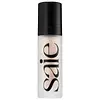What's inside
What's inside
 Key Ingredients
Key Ingredients

 Benefits
Benefits

 Concerns
Concerns

 Ingredients Side-by-side
Ingredients Side-by-side

Water
Skin ConditioningCaprylic/Capric Triglyceride
MaskingPropanediol
SolventGlycerin
HumectantMica
Cosmetic ColorantHydroxyethyl Acrylate/Sodium Acryloyldimethyl Taurate Copolymer
Emulsion StabilisingSqualane
EmollientCaprylyl Glycol
EmollientPhenethyl Alcohol
MaskingEthylhexylglycerin
Skin ConditioningPolysorbate 60
EmulsifyingAscorbyl Tetraisopalmitate
AntioxidantCarica Papaya Seed Oil
HumectantRosa Canina Fruit Oil
EmollientLactic Acid
BufferingCI 77891
Cosmetic ColorantCI 77491
Cosmetic ColorantWater, Caprylic/Capric Triglyceride, Propanediol, Glycerin, Mica, Hydroxyethyl Acrylate/Sodium Acryloyldimethyl Taurate Copolymer, Squalane, Caprylyl Glycol, Phenethyl Alcohol, Ethylhexylglycerin, Polysorbate 60, Ascorbyl Tetraisopalmitate, Carica Papaya Seed Oil, Rosa Canina Fruit Oil, Lactic Acid, CI 77891, CI 77491
Water
Skin ConditioningGlycerin
HumectantDiisostearyl Malate
EmollientMica
Cosmetic ColorantIsopentyldiol
HumectantPolyglyceryl-10 Eicosanedioate/Tetradecanedioate
Skin ConditioningOryza Sativa Starch
AbsorbentBenzyl Alcohol
PerfumingMaris Aqua
HumectantXanthan Gum
EmulsifyingAlcohol
AntimicrobialAcrylates Copolymer
Dehydroacetic Acid
PreservativePistacia Lentiscus Gum
MaskingLecithin
EmollientHydrolyzed Algin
Phenethyl Alcohol
MaskingSucrose
HumectantTin Oxide
AbrasiveCI 77891
Cosmetic ColorantCI 77491
Cosmetic ColorantCI 77492
Cosmetic ColorantCI 77499
Cosmetic ColorantWater, Glycerin, Diisostearyl Malate, Mica, Isopentyldiol, Polyglyceryl-10 Eicosanedioate/Tetradecanedioate, Oryza Sativa Starch, Benzyl Alcohol, Maris Aqua, Xanthan Gum, Alcohol, Acrylates Copolymer, Dehydroacetic Acid, Pistacia Lentiscus Gum, Lecithin, Hydrolyzed Algin, Phenethyl Alcohol, Sucrose, Tin Oxide, CI 77891, CI 77491, CI 77492, CI 77499
 Reviews
Reviews

Ingredients Explained
These ingredients are found in both products.
Ingredients higher up in an ingredient list are typically present in a larger amount.
Ci 77491 is also hydrated iron III oxide. It's sole purpose is to give a red/pink hue to products.
Iron III oxides are classified as inorganic chemicals for coloring.
Synthetically created Ci 77491 is considered safer than those naturally found. This is because the synthetically created version may contain less impurities. Iron oxides are generally non-toxic and non-allergenic.
Learn more about CI 77491Ci 77891 is a white pigment from Titanium dioxide. It is naturally found in minerals such as rutile and ilmenite.
It's main function is to add a white color to cosmetics. It can also be mixed with other colors to create different shades.
Ci 77891 is commonly found in sunscreens due to its ability to block UV rays.
Learn more about CI 77891Glycerin is already naturally found in your skin. It helps moisturize and protect your skin.
A study from 2016 found glycerin to be more effective as a humectant than AHAs and hyaluronic acid.
As a humectant, it helps the skin stay hydrated by pulling moisture to your skin. The low molecular weight of glycerin allows it to pull moisture into the deeper layers of your skin.
Hydrated skin improves your skin barrier; Your skin barrier helps protect against irritants and bacteria.
Glycerin has also been found to have antimicrobial and antiviral properties. Due to these properties, glycerin is often used in wound and burn treatments.
In cosmetics, glycerin is usually derived from plants such as soybean or palm. However, it can also be sourced from animals, such as tallow or animal fat.
This ingredient is organic, colorless, odorless, and non-toxic.
Glycerin is the name for this ingredient in American English. British English uses Glycerol/Glycerine.
Learn more about GlycerinMica is a naturally occurring mineral used to add shimmer and color in cosmetics. It can also help improve the texture of a product or give it an opaque, white/silver color.
Serecite is the name for very fine but ragged grains of mica.
This ingredient is often coated with metal oxides like titanium dioxide. Trace amounts of heavy metals may be found in mica, but these metals are not harmful in our personal products.
Mica has been used since prehistoric times throughout the world. Ancient Egyptian, Indian, Greek, Roman, Aztec, and Chinese civilizations have used mica.
Learn more about MicaPhenethyl Alcohol is a colorless and aromatic alohol. It is naturally occuring in essential oils.
The scent of this ingredient is floral and often compared to rose.
Like other alcohols, this ingredient helps prevent the growth of bacteria. However, its main purpose is to impact a fragrance.
Learn more about Phenethyl AlcoholWater. It's the most common cosmetic ingredient of all. You'll usually see it at the top of ingredient lists, meaning that it makes up the largest part of the product.
So why is it so popular? Water most often acts as a solvent - this means that it helps dissolve other ingredients into the formulation.
You'll also recognize water as that liquid we all need to stay alive. If you see this, drink a glass of water. Stay hydrated!
Learn more about Water